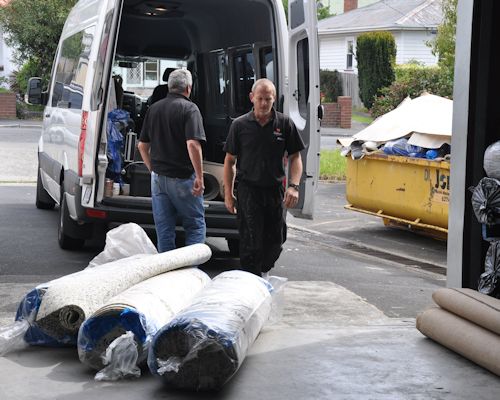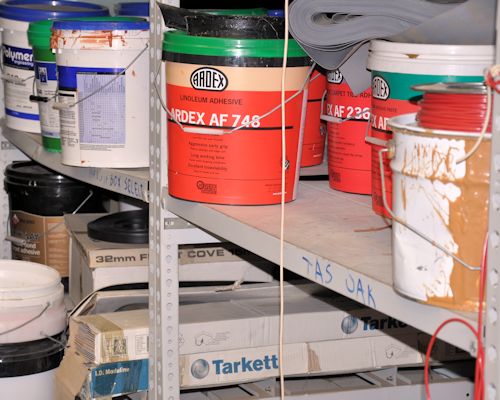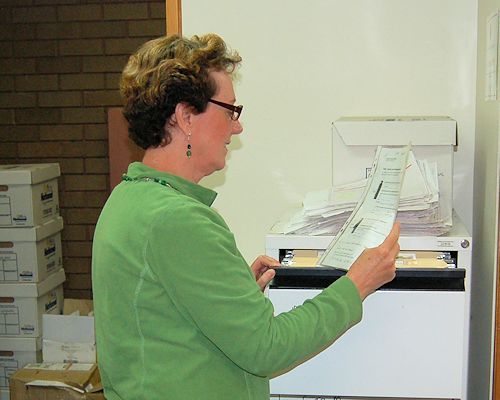Storage and handling
 Audio for slide 1 (mp3 |6|KB)
Audio for slide 1 (mp3 |6|KB)
The SDS for each product will set out the requirements and any special precautions that must be observed.
Below are some of the issues you must take into account when storing or handling these products.

 Audio for slide 2 (mp3 |6|KB)
Audio for slide 2 (mp3 |6|KB)
Labelling and packaging
Always make sure a product is correctly labelled before you put it on the shelf or in a storage area.
Obviously, if it's still in its original packaging it will be properly labelled.
But if you've decanted the product into another container, or saved some left-overs for another job, you should always write the name of the product on the new bottle or packet.
You also need to make sure that the new container is suitable for the product - that is, made of the right materials to avoid chemical reactions, the right shape to avoid spillages, able to be sealed tight if necessary, and so on.

 Audio for slide 3 (mp3 |6|KB)
Audio for slide 3 (mp3 |6|KB)
Check that you still have an SDS for the product on hand, even if you are no longer using the original container that the product came in.
Workers should be able to access the SDS easily at any time, especially if there is an incident on-site that demands a quick response.
If you come across a container that isn't properly labelled, take it straight to your supervisor and ask them to identify the substance.
This will allow them to either write the correct name on the container or dispose of it safely.

 Audio for slide 4 (mp3 |6|KB)
Audio for slide 4 (mp3 |6|KB)
Segregation
Some products can cause chemical reactions with other substances if they come into contact with each other, or give off dangerous fumes or explosive gases under certain conditions.
The SDS for each product will provide advice on how far away it must be kept from incompatible products and what sort of atmospheric conditions need to be maintained.
The ADG Code also provides information on which dangerous goods need to be segregated from each other.

 Audio for slide 5 (mp3 |6|KB)
Audio for slide 5 (mp3 |6|KB)
Storage and handling conditions
Some products need to be stored under cool, dry conditions. There are also maximum and minimum temperatures that apply to mixing or using certain chemicals. The SDS will specify these requirements.
Below are some general storage and handling principles:
- keep packages and containers secure and firmly sealed when they're not being used, so that they can't spill, leak or give off vapours
- check on dangerous goods regularly to make sure there are no leakages and that the atmospheric conditions are being maintained, such as correct temperature and ventilation
- if you need to decant or transfer a chemical from one container to another, do it in a suitable area, with a spill kit nearby, and wearing the correct PPE
- make sure ignition sources are kept well away from flammable or combustible dangerous goods - including sparks from grinders or welders, flames from cigarette lighters and oxy torches, and any other potential source of a spark or flame
- maintain good ventilation around products that require it, especially when there is the danger of a build-up of fumes or gases.

 Audio for slide 6 (mp3 |6|KB)
Audio for slide 6 (mp3 |6|KB)
Hazardous chemical register
Under WHS legislation all workplaces, including construction sites, must keep an up-to-date register of the hazardous chemicals being used and stored, together with a current SDS or MSDS for each chemical.
Below is an example of a typical template used for a hazardous chemical register.
| Name of substance | Location | SDS/MSDS date | GHS or Dangerous Goods class | Maximum amount stored |
|---|---|---|---|---|
| Mineral Turpentine | Storage room | 2014 | Class 3: Flammable liquid | 20 litre container |
| LP gas | Storage room | 2015 | Class 2: Flammable gas | 15 kg cylinder |


Learning activity
Audio 7 (mp3 |6|KB)Go to the hazardous chemicals storage area at your workplace.
Have a look at the hazardous chemicals register. If you don't know where it is, ask your supervisor.
Answer the following questions.
Is the register set out like the sample template shown above? If not, what extra columns are there?
Is there an SDS or MSDS for every dangerous or hazardous substance you have on-site (or are carrying in your vehicle)? Where are these documents held?





